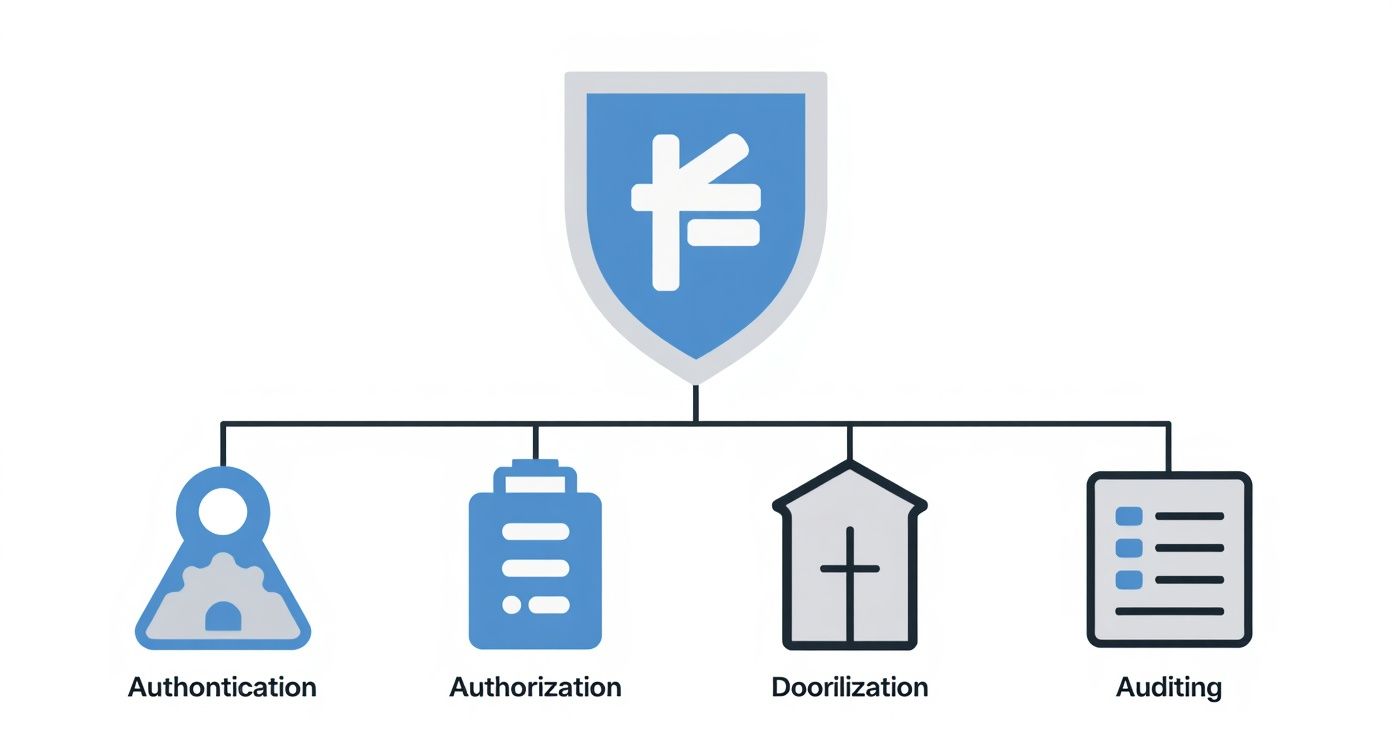At its heart, Identity Management (or IdM) is the framework an organization uses to make sure the right people can get to the right digital resources, especially sensitive ones like hosted email platforms. Think of it as your company's digital gatekeeper, controlling who gets into your email system, what they can see, and when they can see it.
The whole system is built to answer two simple but critical questions: "Who are you?" and "What are you allowed to do here?"
Understanding Identity Management Beyond the Jargon
Let's try a simple analogy. Picture your company's entire digital world—all its data, apps, and systems—as a secure corporate building. Inside, you have everything of value: sensitive customer files, financial data, secret project plans, and your private communication hub, the email platform.
Without a security system, it would be a free-for-all. Anyone could wander in, open any door, and walk away with your most confidential information. Identity management is that building's entire security system, from the front desk guard to the keycard readers on every door. It's the bouncer, guest list, and keymaster, all working together to protect what matters, especially your email privacy.
The Digital Keycard Analogy
Let's stick with that building analogy for a moment. When you hire a new employee, you give them a digital keycard. That keycard is their unique digital identity—it's how the building's security system knows who they are. The process of creating, managing, and eventually deactivating that keycard is identity management.
But having a keycard is only half the story. The system also needs to know which doors that specific keycard can open. This is called authorization. A new marketing assistant’s keycard might get them through the main entrance and onto the marketing floor, but it’s not going to unlock the server room or the CEO's office.
An effective identity management strategy is the first line of defense for your digital assets. It ensures that only the right people can access sensitive information, which is especially vital for maintaining email privacy and security on hosted platforms.
To really get a grip on how IdM works, it helps to break it down into its three core functions. These pillars work together to form a complete, robust system.
The Three Pillars of Identity Management
A quick overview of the core functions that form a complete identity management system.
| Pillar | Core Question It Answers | Analogy (Digital Keycard System) |
|---|---|---|
| Authentication | "Are you really who you say you are?" | The system verifies the keycard itself. Is it a valid, active card issued by security? |
| Authorization | "What are you allowed to do here?" | The system checks if the verified keycard has permission to open a specific door. |
| Auditing | "What did you do while you were here?" | The system logs every time the keycard is used, recording which doors were accessed and when. |
Together, these three pillars ensure that access is not only granted correctly but is also monitored continuously, providing a full picture of who is doing what within your digital "building."
Connecting Identity to Email Security
This entire framework is absolutely critical for protecting your company’s email. Your hosted email system is a goldmine of confidential data, and without solid identity management, a single stolen password could give a hacker the keys to the kingdom.
A strong IdM system bolts down your email security in a few key ways:
- Verifying Users: It makes sure the person trying to log into an email account is the real deal, often by requiring a second form of verification, like a code from their phone (Multi-Factor Authentication or MFA).
- Controlling Access: It enforces rules about what users can do once they're inside. This prevents someone from, say, accessing a shared executive mailbox they shouldn't be able to see, protecting email privacy.
- Auditing Activity: It keeps a detailed log of every login and action. If a suspicious email breach happens, you have a clear trail to follow during an investigation.
This "verify, then trust" approach is a cornerstone of modern cybersecurity. It fits perfectly with the principles we cover in our guide on what is Zero Trust security and why it matters, where nobody gets a free pass just because they're on the company network.
This goes beyond just internal security, too. Properly managing digital identities is fundamental to meeting regulatory requirements, such as those found in Know Your Customer (KYC) and Know Your Business (KYB) processes. When you get identity right, you build a secure foundation for everything else you do.
Breaking Down the Core Components of an IdM System
An identity management system isn't a single piece of software you just install and forget. It’s more like a team of specialists, each with a specific job, all working together to protect your digital environment. To really get what’s happening, you have to look at the four pillars that hold the whole thing up.
Each one plays a unique role, but when combined, they create a powerful security framework for everything you do online—especially for high-stakes assets like your company's hosted email platform.

As you can see, authentication, authorization, and auditing are the bedrock of any solid IdM strategy. They each answer a fundamental security question to make sure the right people have the right access at the right time.
Identity Lifecycle Management
The first piece of the puzzle is managing the entire journey of a digital identity, from the moment it’s created to the day it’s retired. This isn't just a technical checklist; it's a vital business process that directly impacts your email security and efficiency. Think of it as the HR department for your digital workforce.
When a new employee joins, their email account is automatically set up on your hosted platform with the permissions they need. More importantly, the second they leave the company, their access to that mailbox and all its sensitive data is cut off instantly. This closes a huge, and very common, email security gap.
Authentication Methods
Once an identity is created, the system needs to prove that the person logging in is actually who they say they are. This is authentication, and it’s the bouncer at the front door of your hosted email platform. In today's threat environment, a simple username and password just doesn't cut it anymore.
Modern IdM systems use much stronger methods to lock that door down, making it incredibly difficult for an attacker to get into an email account, even if they've stolen a password.
- Multi-Factor Authentication (MFA): This is the industry standard for a reason. It forces users to provide more than one piece of evidence to prove their identity—like a password (something you know) and a code from your phone (something you have).
- Biometrics: Using something unique to you, like a fingerprint or facial scan, is a fantastic way to verify identity. It's convenient and incredibly secure.
- Single Sign-On (SSO): While it feels like a simple convenience, SSO actually boosts security. By reducing the number of passwords people have to juggle, you also reduce the risk of them using weak or reused credentials that could compromise their email account.
Strong authentication is your first line of defense for email privacy. To see how this works in practice, you can read our deep dive into how a guide to multi-factor authentication strengthens email security. Just by adding MFA to your hosted email, you make it exponentially harder for an attacker to access private communications.
Authorization Policies
After a user has proven their identity, authorization kicks in to decide what they are actually allowed to do. This works on the "principle of least privilege," which is a fancy way of saying people should only get access to the information and tools they absolutely need to do their jobs—and nothing more.
This is where you get really granular control. For instance, in a hosted email system, a good IdM platform can enforce policies that:
- Stop a junior employee from ever seeing the executive team's shared mailbox.
- Limit a contractor's email access to only the project folders they are assigned to.
- Prevent users from changing important security settings on their own email accounts.
These policies aren't set in stone; they're dynamic rules that follow users across every application, ensuring that even verified people can't wander into areas where they don't belong. This is essential for both email security and overall data privacy.
Authorization is the digital equivalent of giving an employee a key that only opens the doors they need. It contains the risk of a compromised account by limiting the potential damage an intruder can cause within your email platform.
Auditing and Reporting
The final, and often overlooked, component is auditing and reporting. This function is the security camera of your system, creating a complete record of who did what, where, and when. This audit trail is priceless for email security investigations and compliance mandates.
If a security incident happens, like a suspected email breach, these logs are the first place your security team will look. They can quickly see how an attacker got in, which mailboxes they accessed, and what data they touched. This isn't just for cleaning up messes, either. Proactively reviewing these logs helps spot suspicious behavior before it becomes a full-blown crisis.
The growing need for this kind of robust security is driving massive market growth. The global consumer identity and access management market was valued at USD 17.86 billion in 2024 and is on track to hit USD 47 billion by 2034, all because companies need to provide secure, trustworthy digital experiences.
Why Investing in Identity Management Is a Game Changer
It’s easy to write off identity management (IdM) as just another IT line item, another cost center. But that’s a huge mistake. A well-thought-out IdM strategy is one of the most powerful business tools you can have, turning what seems like a defensive tactic into a real competitive edge that sharpens efficiency, tightens security, and builds trust.
The benefits aren't just theoretical, either. They show up on your bottom line and in your ability to bounce back from problems. The most immediate impact? A massive drop in your risk of a data breach. When you have a firm grip on who can access what, you fundamentally shrink the target for attackers. This is especially true when it comes to your most valuable—and vulnerable—asset: your company email platform.
Fortifying Email Privacy and Security
Think about what lives in your company’s email system. It’s a treasure trove of sensitive contracts, private customer information, and your most valuable intellectual property. A single stolen password could give a bad actor a front-row seat to all of it. A solid IdM system acts as a digital fortress around your hosted email.
For starters, it slams the door on unauthorized mailbox access. By requiring strong authentication—like a code from your phone on top of a password—IdM makes stolen credentials practically useless. Even if an attacker has the password, they still can't get into an email account.
It also solves the problem of intellectual property walking out the door when an employee leaves. With automated de-provisioning, the moment an employee is offboarded, their access to company email and other critical systems is instantly shut down. This one step closes a common and incredibly costly security gap.
A well-implemented identity management system moves beyond just password policies. It becomes the guardian of your digital conversations, ensuring that email privacy is a default setting on your hosted platform, not an afterthought.
Boosting Operational Efficiency Through Automation
Beyond the critical security wins, IdM is a huge productivity booster. Just picture the manual grind of setting up a new hire's accounts—especially their email—or painstakingly revoking access for someone who’s left the company. That process is almost always slow, wide open to human error, and a massive time-suck for your IT team.
IdM automates that entire lifecycle, from start to finish.
- Day One Access: A new employee can hit the ground running on their first day, sometimes within their first hour. The system automatically creates their email account and grants access to the right software based on their role. No more waiting around.
- Seamless Changes: When someone gets a promotion or moves to a new department, IdM can automatically update their access rights to fit their new responsibilities.
- Instant Offboarding: As we touched on, email access is cut off immediately and automatically when an employee leaves. This gets rid of manual checklists and the very real risk of orphaned accounts.
This level of automation frees up your IT crew to work on projects that actually move the business forward, instead of getting bogged down in repetitive admin tasks. Plus, it ensures your access policies are applied the same way, every single time, without fail.
Simplifying the Web of Regulatory Compliance
Staying on the right side of regulations like GDPR, HIPAA, or Sarbanes-Oxley is a major headache for any modern business. These rules demand strict controls over sensitive data—like that found in email—and require you to have detailed audit trails to prove you’re doing it right. IdM is your best friend when it comes to untangling this complex web.
It gives you the fine-grained control and detailed logging you need to show that you're protecting customer and company data responsibly. When auditors come knocking, the reports from your IdM system can show them exactly who accessed what email data, when they did it, and why. It turns a nail-biting audit into a straightforward review.
This absolute need for verifiable security is fueling some serious market growth. The global Identity and Access Management (IAM) market was valued at USD 15.93 billion in 2022 and is projected to skyrocket to USD 41.52 billion by 2030. According to insights from Grandviewresearch.com, this explosion is a direct response to rising threats and the growing pressure to prove compliance. Ultimately, investing in IdM isn't just about dodging fines; it’s about building a business on a foundation of trust and security.
How Identity Management Works in the Real World
Theory is one thing, but seeing identity management in action is where it all clicks. It’s the invisible engine running in the background of our digital lives, quietly making things both smoother and more secure.
Let's move past the technical jargon and look at a few real-world examples. We'll follow a new hire on their first day, a customer logging into their bank, and a student navigating their university portal. These everyday situations show just how IdM works without ever getting in your way.

Onboarding a New Employee
Picture Sarah, a new marketing specialist, on her first day. Even before she walks through the door, HR has already entered her details into the company system. That one action sets off a chain reaction, all managed by the company’s identity management platform.
Instantly, the system starts creating all the accounts she’ll need. This is called user provisioning. An account is spun up for the project management tool, she gets access to the shared marketing drive, and, of course, her corporate email address is created on the company's hosted email platform.
But it’s smarter than just creating accounts. The IdM platform uses a role-based access control (RBAC) policy designed specifically for the marketing team. Sarah’s email is automatically configured with the right permissions—she can see the team’s shared mailbox, but she can’t access sensitive executive messages. This is how you get strong email privacy right from the start. This automated setup is a core part of the nine employee onboarding best practices for 2025 that companies are using to be more secure and efficient.
Securing a Customer Bank Account
Now, let's switch gears to a banking customer, David. He goes to his bank's website to check his balance and types in his username and password. But he doesn't get in just yet.
Instead, the bank’s IdM system kicks in a second, crucial step: it sends a one-time code to his smartphone. This is Multi-Factor Authentication (MFA), a non-negotiable for securing sensitive accounts today. The system is confirming David's identity with two distinct factors: something he knows (his password) and something he has (his phone).
Even if a thief managed to steal David's password, they'd be stopped cold without his phone. This simple but powerful layer of security is what stands between a criminal and your financial data. The same principle applies directly to email security.
Empowering a University Student
Finally, think of a university student named Maria. In a single day, she might need to log into the library's research database, the course registration portal, class forums, and her student email. That’s a lot of passwords to remember.
Except she doesn't have to. Maria logs in once to the main university portal, and that’s it. This is Single Sign-On (SSO), one of the most user-friendly features of a good identity management system. After that first login, she can jump between all those different tools without being asked for a password again.
What’s happening behind the scenes? The university's IdM system is essentially vouching for Maria to every other application. It tells the library, "Yep, she's an enrolled student, let her in," and tells the email provider, "She’s authorized for this mailbox."
It's a win-win. Maria gets a seamless experience, and the university’s IT department has a single, central point of control for security.
These principles aren't just for big organizations. As our lives move more online, the market for personal identity management has exploded. It was valued at USD 22.2 billion in 2024 and is expected to hit USD 63.6 billion by 2033. As you can discover more about this market's growth drivers, things like remote work and the explosion of smart devices are making personal IdM more essential than ever.
Common IdM Hurdles and How to Clear Them
Putting a new identity management (IdM) system in place is a huge win for security, but it’s never as simple as flipping a switch. You’re guaranteed to hit some bumps along the way. These roadblocks aren't just about technology; they're about people, old habits, and the systems you already have.
One of the biggest headaches is trying to connect a sleek, modern IdM solution with clunky legacy systems that were never designed for today's security threats. Another classic challenge is getting your team on board. If employees see new rules like multi-factor authentication as just another hassle, they'll fight it every step of the way, leaving big security gaps in things like their email accounts.

Embrace the Principle of Least Privilege
One of the most powerful concepts in all of security is the Principle of Least Privilege (PoLP). It’s a simple idea with massive implications: give people the absolute minimum access they need to do their jobs. Nothing more, nothing less.
Think of it this way: you wouldn't give every employee a master key to the entire building. You give them a key that only opens their own office. PoLP does the same thing for your digital world. Applied to your email system, it means a regular employee’s account—even if it gets compromised—can’t be used to peek into executive inboxes or mess with company-wide settings. This single principle dramatically shrinks your attack surface.
Make Regular Access Reviews a Habit
People don't stay in the same role forever. They get promoted, switch teams, or leave the company. If you aren't paying attention, their access rights can pile up over time, creating a dangerous situation called "privilege creep." Before you know it, a single account might have far more power than anyone realizes.
Smart organizations fight this by making access reviews a non-negotiable routine. At set intervals, you need to audit who has access to what, especially for critical systems like your hosted email platform. These reviews are your chance to ensure permissions still make sense for someone's current role and, most importantly, to double-check that former employees can't get back in.
Regular access certification is not just about ticking a compliance box. It’s an active defense that systematically weeds out outdated permissions, keeping critical data like private emails locked down tight.
Part of this process involves aligning with strong data privacy policies, which guide how you should handle, store, and protect identity data from start to finish.
Become a Champion for Multi-Factor Authentication
If you do only one thing, make it this: implement Multi-Factor Authentication (MFA) everywhere you can. Stolen passwords are behind an incredible number of data breaches. MFA stops this dead in its tracks by asking for a second piece of proof, making a stolen password practically worthless to an attacker.
Of course, getting people to actually use it can be tough. The secret is to be a champion for MFA, not just a dictator.
- Explain the "Why": Don't just tell people to turn it on. Show them how it protects the company and even their own personal information, especially when it comes to email privacy. It’s the digital equivalent of a seatbelt.
- Give People Choices: Let users pick what works for them. A push notification from an app, a text message code, or a physical security key are all great options.
- Protect Your Crown Jewels First: Roll out MFA on your most critical systems immediately. That means your email platform, VPN, and any administrative accounts should be first in line.
The following table breaks down these essential practices for getting your IdM implementation right from the start.
A Checklist for Successful IdM Implementation
Essential practices for deploying and maintaining a powerful identity management system.
| Best Practice | Why It's Critical | Direct Impact on Email Security |
|---|---|---|
| Principle of Least Privilege (PoLP) | Restricts user access to the bare minimum needed for their job, reducing the potential damage from a compromised account. | Prevents a standard user's hacked account from accessing sensitive mailboxes or changing administrative email settings. |
| Regular Access Reviews | Fights "privilege creep" by ensuring permissions are current and revoking access for former employees promptly. | Guarantees that only active, authorized employees can access company email, closing off a common entry point for attackers. |
| Universal MFA Adoption | Adds a crucial layer of security that makes stolen passwords useless without a second verification factor. | Secures email accounts against phishing and credential stuffing attacks, which are the #1 cause of email breaches. |
| Strong Password Policies | Enforces complexity and regular rotation, making passwords harder to guess or crack through brute-force methods. | Makes it significantly more difficult for attackers to gain initial access to an employee's inbox through password-based attacks. |
By tackling these common issues head-on with proven strategies, you can build an IdM system that’s not just strong, but also built to last.
Taking Your Next Steps In Identity Management
You’ve peeled back the layers of identity management, seeing how authentication, authorization and account provisioning come together to shield your inbox. Now it’s time to move from understanding to action—your next mission is to assess what’s standing between your users and a secure email environment.
Start by inspecting your access controls with fresh eyes. Are you prompting everyone for Multi-Factor Authentication at every login, especially on your hosted email platform? And how fast do privileges disappear when someone leaves the team?
A weak password is like a door left unlocked—it’s an open invitation for trouble, especially for your email security.
Securing Your Digital Doors
Think of each user account as a doorway into your network. If that door isn’t bolted shut, sensitive messages and data can slip out without you ever noticing. Begin with a quick audit of your hosted email platform’s security options.
Focus on these key areas:
- MFA Enforcement: Is it optional or mandatory for every single user?
- Role-Based Access: Are permissions strictly limited to what each person needs?
- Offboarding Protocol: Does your system automatically revoke email access when staff depart?
Answering these questions gives you a clear roadmap. It’s the difference between knowing how identity management works and actually blocking threats to your email privacy in real time.
Got Questions About Identity Management?
You've got the basics down, but let's clear up a few things that tend to trip people up. Nailing these details is what separates a decent security setup from a great one.
What’s the Real Difference Between Identity and Access Management?
It's easy to see why these two get tangled up—they're always mentioned together as "IAM." But think of them as two different jobs handled by two different specialists. They work together, but they don't do the same thing.
Identity management is all about the "who." It’s the process of creating and verifying a person's digital identity. Going back to our building analogy, this is the HR department creating an employee profile, taking their photo, and issuing them a unique ID badge. It proves you are who you say you are.
Access management, on the other hand, is about the "what." It takes that verified ID badge and decides which doors it can unlock. It doesn't care who you are; it trusts the identity system already handled that. Its only job is to enforce the rules—"Can this person access the finance team's shared mailbox? Yes or no?"
Identity management confirms you're Jane Doe. Access management checks the list to see if Jane Doe is allowed into the executive suite.
How Exactly Does IdM Protect Cloud Email Platforms?
For services like Microsoft 365 or Google Workspace, identity management isn't just a feature—it's the foundation of their security. It protects your company's most vital communication channel in a few key ways, boosting both email security and privacy.
First, it bolts the front door shut with multi-factor authentication (MFA). This single step makes stolen passwords almost useless to an attacker. Think of it as needing both a key and a PIN to get into your inbox, not just the key.
Second, it controls what people can do after they're logged in. By setting up specific roles and permissions, you can stop a regular user from peeking into a sensitive executive mailbox or messing with company-wide security settings. This directly protects email privacy.
Finally, automated de-provisioning is a lifesaver. The moment an employee's status changes to "former," their email access is cut off. Instantly. This slams the door on a huge potential security hole, preventing company data from walking out with them.
Is Identity Management Only for Huge Companies?
That's an outdated idea. It used to be true when the only options were complex, expensive systems that lived on-site. But the rise of cloud-based Identity as a Service (IDaaS) solutions has completely changed the game.
Now, powerful IdM is both affordable and accessible for businesses of any size.
In fact, you probably already have access to strong identity management tools. Most major SaaS platforms—including hosted email—come with built-in features that small businesses can switch on with just a few clicks. Simply enforcing MFA and setting up a few basic user roles can give you a massive email security boost, no big budget or dedicated IT department required. The tools are right there, waiting for you to use them.
Ready to take back control of your email privacy and security? Typewire provides secure, private email hosting for people and businesses who value their data. Stop the tracking and data mining for good.
Explore Typewire's features and start your free trial today.






